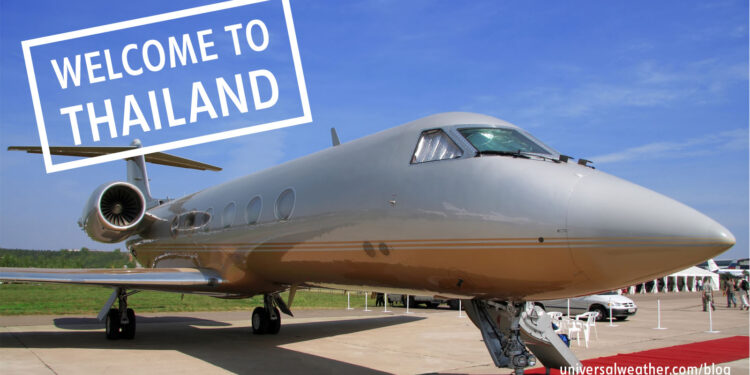Planning BizAv Operations to Thailand – Part 1: Permit Planning

This business aviation blog post is part of a series on operations to Thailand.
Pre-planning is essential when you conduct business aircraft operations to Thailand. There are many important factors to consider in terms of landing permits, aircraft parking, and cabotage. A missed item or planning consideration could delay your flight or even stop it in its tracks. When you apply for Thai permits, it’s best to allow plenty of lead time and to coordinate closely with your ground handler or 3rd-party provider.
The following is an overview of what you need to know when operating to Thailand:
1. Airport slots, PPRs, and landing permits
Most airports in Thailand – including Don Muang, Bangkok (VTBD), Suvarnabhumi, Bangkok (VTBS), and Rayong (VTBU) – require airport slots to be obtained prior to landing permits being issued. At certain locations – including VTBD and Phuket (VTSP) – Prior Permission Required (PPR) is also needed to obtain airport parking. Depending on the airport authorities, airport slot and PPR status will usually be known within five days of the request, if not sooner. Slots and PPRs are arranged via your ground handler and should always be requested well in advance. Be advised that during the October-March high season, many airports may be congested, and aircraft parking may be limited. Notices to airmen, especially for VTSP, may state that only short-term parking – for example a drop-and-go – is permitted. This can introduce an additional level of complexity to the trip, particularly for charter operations close to crew duty time limits.
2. Overflight permits
Permits are required for all overflights of Thailand, and official lead time is 10 business days for private non-revenue and for charter (non-scheduled commercial) flights. Permits can usually be processed with less notice (a minimum of three business days is recommended for short-notice permits), but this is at the discretion of the Civil Aviation Authority (CAA). Be aware that CAA is particular regarding departure and destination points. Any change to a departure/destination point, even if it’s within the same country, requires a revision of your overflight permit. Permit revisions are always required for changes of origin/destination, changes in schedule – if outside the +/- 24-hour permit window – and route changes.
3. Thailand landing permits
Official lead times are 10 business days for private non-revenue and 15 business days for charter landing permits. Short-notice and emergency permit requests may be accommodated at CAA’s discretion. In practice landing permits can often be obtained within two to three days, after airport slots are confirmed, which can take up to three days. Permit confirmation must be added to remarks section 18 of your International Civil Aviation Organization flight plan. Thailand permits are valid for +/- 24 hours and revisions are required for:
- change in origin
- change in departure/arrival time when outside the 24-hour permit window
- change in arrival airport
- route changes
- change in passenger number
At least 24 hours’ notice is needed for permit revisions. Note that CAA operating hours are Monday-Friday, 0800-1400 local, and CAA is closed holidays (including New Year’s, Lunar New Year’s, and Songkran festival) and weekends. Emergency permits may be processed during CAA’s official closed hours; however, this is at discretion of CAA. Customs, immigration, and quarantine clearance is not required for tech stops so long as no crew members/passengers embark/disembark. Even though both landing and overflight permits are valid +/- 24 hours, it is recommended to send a notification of any schedule change if the change is more or less than 20 hours.
4. Permit documentation
Aircraft documents are not needed for landing permits. Information required for permits is essentially the same for both private non-revenue and charter. With a landing permit request, you’ll need to provide full schedule, purpose of flight, crew/passenger information per leg, and a business contact. You cannot submit “to be advised” schedules with your landing permit application as CAA will not process it. General Aviation (GA) operations to VTBS are only permitted if passengers have confirmed connecting flights with a scheduled airline. In order to obtain a landing permit for VTBS, you must submit passenger connecting airline ticket information along with the permit application.
5. Business contact requirements
A business contact must be submitted with all landing permit requests for Thailand. The exception is for tech stops during which no crew members or passengers can embark or disembark the aircraft. Otherwise, you’ll need to provide the full name, title, address, and contact information of the business contact. Note that CAA will contact this person, so it’s important that your business contact be prepared for the call. Always include a specific purpose of flight, in the landing permit request, as a general purpose of “business flight” will not be accepted by CAA.
6. Cabotage rules is strictly enforced
Both private non-revenue and charter operations to Thailand are subject to cabotage rules/restrictions, and CAA pays close attention. If, in a landing permit request, the number of passengers/crew members differs per leg, special permission may be required from CAA, with approval/disapproval at their discretion.
Conclusion
For GA travel to Thailand, it’s best to provide a minimum of two weeks’ notice in order to ensure that permits and all necessary arrangements are in place. While short-notice permits are often possible, last-minute trip approvals can never be guaranteed.
Questions?
If you have any questions about this article or would like assistance planning your next trip to Thailand, contact me at christopherbarnes@univ-wea.com.
Stay tuned for Part 2, which covers customs, immigration, and quarantine and aircraft services for Thailand.




